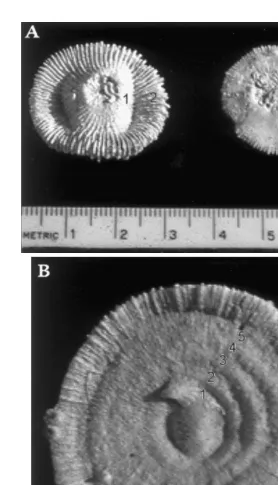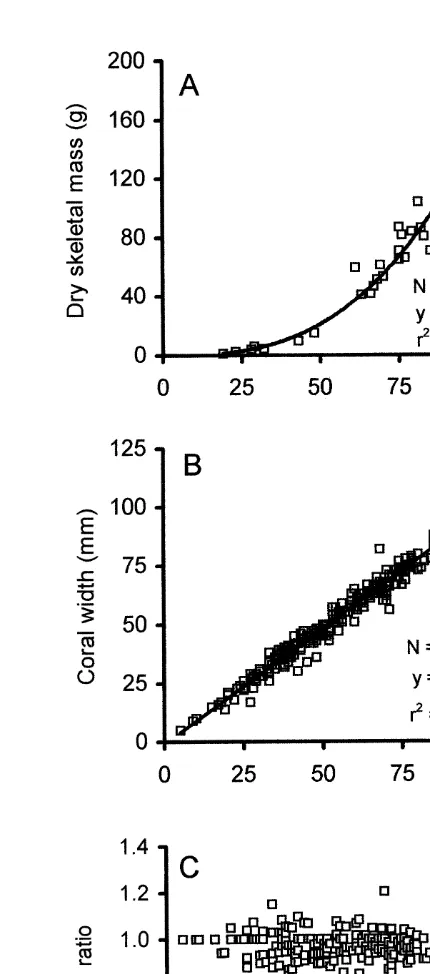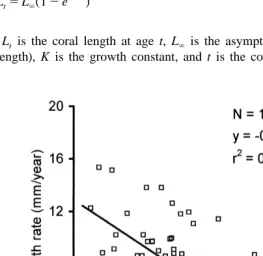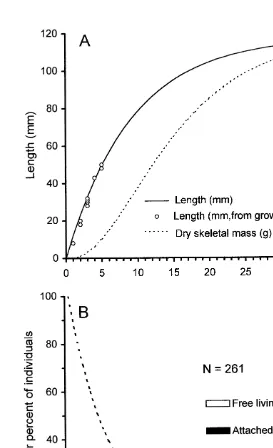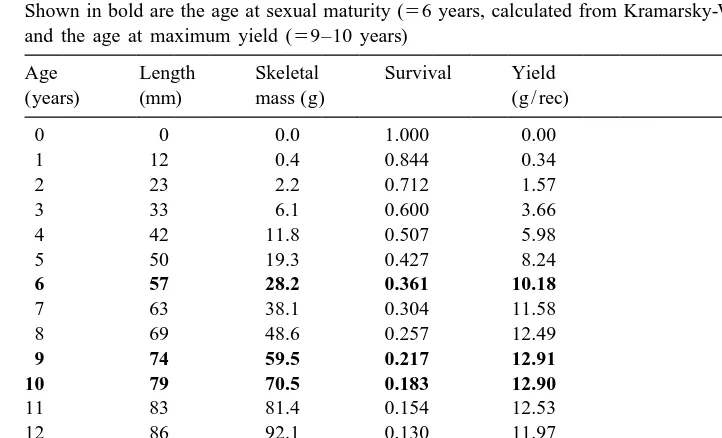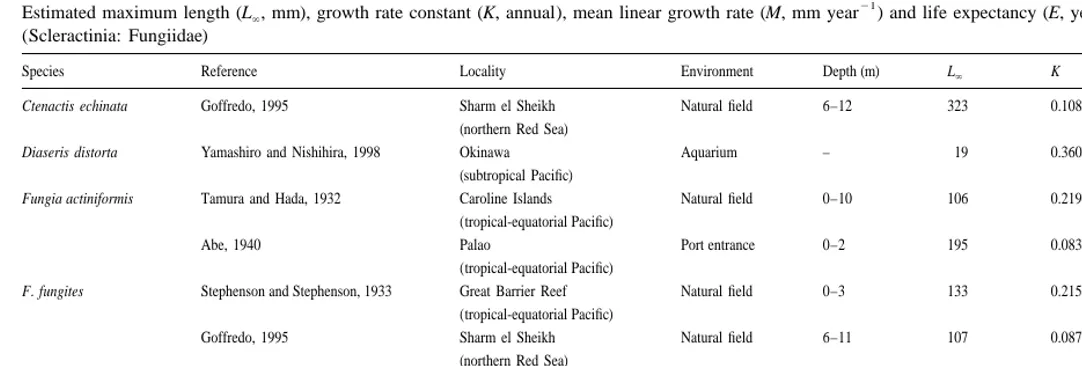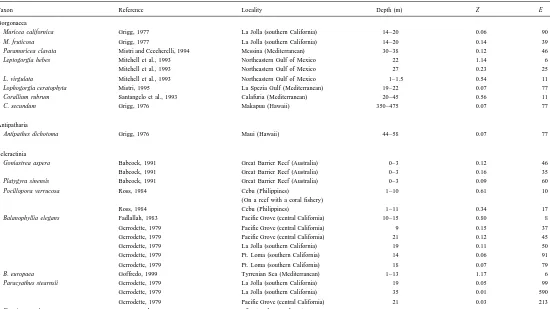L
Journal of Experimental Marine Biology and Ecology 249 (2000) 199–218
www.elsevier.nl / locate / jembe
Growth and population dynamic model of the reef coral
Fungia granulosa Klunzinger, 1879 at Eilat, northern Red
Sea
a,b ,* c d
Nanette E. Chadwick-Furman , Stefano Goffredo , Yossi Loya
a
Interuniversity Institute for Marine Science, P.O. Box 469, Eilat, Israel b
Faculty of Life Sciences, Bar Ilan University, Ramat Gan, Israel c
Department of Evolutionary and Experimental Biology, University of Bologna, via Selmi 3, I-40126
Bologna, Italy d
Department of Zoology, The George S. Wise Faculty of Life Sciences, and the Porter Super-Center for
Ecological and Environmental Studies, Tel Aviv University, Tel Aviv, Israel Received 18 August 1999; received in revised form 10 February 2000; accepted 9 March 2000
Abstract
The lack of population dynamic information for most species of stony corals is due in part to their complicated life histories that may include fission, fusion and partial mortality of colonies, leading to an uncoupling of coral age and size. However, some reef-building corals may produce compact upright or free-living individuals in which the above processes rarely occur, or are clearly detectable. In some of these corals, individual age may be determined from size, and standard growth and population dynamic models may be applied to gain an accurate picture of their life history. We measured long-term growth rates (up to 2.5 years) of individuals of the free-living mushroom coral Fungia granulosa Klunzinger, 1879 at Eilat, northern Red Sea, and determined the size structure of a population on the shallow reef slope. We then applied growth and population models to the data to obtain estimates of coral age, mortality rate, and life expectancy in members of this species. In the field, few F. granulosa polyps suffered partial mortality of .10% of their tissues. Thus, the majority of polyps grew isometrically and determinately, virtually ceasing growth by about 30–40 years of age. Coral ages as revealed by skeletal growth rings were similar to those estimated from a growth curve based on field data. The frequency of individuals in each age class on the reef slope decreased exponentially with coral age, indicating high mortality rates when corals were young. The maximum coral age observed in the field population (31 years) was similar to that estimated by application of a population dynamic model (30 years). Calculated rates of growth, mortality and life expectancy for F. granulosa were within the range of those known for other stony corals. Our results reveal a young, dynamic population of this species on Eilat reefs, with high turnover rates and short lifespans. Such information is important for understanding
*Corresponding author. Tel.:1972-7-636-0101; fax:1972-7-637-4329.
E-mail address: furman@mail.biu.ac.il (N.E. Chadwick-Furman)
recovery of coral reefs from disturbances, and for application to the management of commercially exploited coral populations. 2000 Elsevier Science B.V. All rights reserved.
Keywords: Fungiidae; Growth model; Mushroom coral; Population ecology; Red Sea; Reef management; Scleractinia
1. Introduction
Processes of population turnover among stony reef-building corals are important in that they influence how rapidly and to what extent coral reefs recover from disturbances (Connell, 1973). Patterns of larval survival, juvenile recruitment, somatic growth, sexual reproduction and mortality vary widely among species of corals, and play a decisive role in species succession on developing reefs (Grigg and Maragos, 1974; Hughes and Jackson, 1985). Some scleractinians, such as species of the branching corals Stylophora and Pocillopora, have been classified as r-strategists in that they produce a large number of propagules over a long season each year, grow rapidly, and are among the first to colonise newly created space on reefs (Grigg and Maragos, 1974; Loya, 1976a,b; Connell et al., 1997). Others, in particular those with massive hemispherical growth forms such as some species of Porites and Platygyra, may be K-strategists in that they reproduce only during a short period each year and grow slowly (Babcock, 1991; Shlesinger and Loya, 1991), and thus may take several years to colonize new substrata, but once established are able to dominate reefs via effective defense of living space (Grigg and Maragos, 1974). Thus, the life history characteristics of each coral species may explain in large part the observed variation in coral community structure between patches with different disturbance histories on shallow reefs.
The current lack of basic population dynamic information for most stony corals is due in part to a distortion of the relationship between colony size, age and genetic origin, because many colonies may experience fission, fusion, or partial mortality (Hughes and Jackson, 1985; Babcock, 1991). Thus, studies on foliaceous and encrusting corals have relied on long-term observations of individual colonies in order to determine their history and origins, and have used size-based rather than age-based models of population dynamics (Hughes, 1984; Hughes and Jackson (1985), but see Babcock (1991) for a combination of models). However, some corals on reefs grow in distinct forms that rarely undergo fission or fuse, and in which partial mortality is clearly detectable by distortions of the regular growth form. These include stony corals that build compact branching colonies, such as Pocillopora (Grigg, 1984; Ross, 1984) and Stylophora (Loya, 1976a), some with massive hemispherical growth forms such as Platygyra and
Goniastrea (Babcock, 1991), and free-living corals such as Fungia (Chadwick and
Loya, 1990), Manicina (Johnson, 1992) and Siderastrea (Lewis, 1989). In some of these corals, individuals may be aged reliably, thus standard age-based growth and population dynamic models may be applied to understand their demography.
including the scleractinian corals Pocillopora verrucosa (Grigg, 1984; Ross, 1984) and
Balanophyllia europaea (Goffredo, 1999). This model also has been proposed for use in
managing exploited populations of stony reef corals in the Philippines (Ross, 1984). The Beverton Holt model characterises the population dynamics of a given species based on the size frequency distribution of individuals in the field, individual growth rates, and the relationship between individual mass and length. The most important constraint of this model is the assumption that a population is in steady state, in other words that no major disturbance has recently altered population size structure. For species of short-lived corals, or those in relatively deep or stable environments, this may not be a serious limitation (Fadlallah, 1983; Grigg, 1984; Ross, 1984; Mistri, 1995). This is a cohort-based model, in which a cohort of recruits is estimated to gain biomass until an age–size point at which losses to the cohort due to mortality overtake gains in biomass due to individual growth. After this point, as the cohort ages, its biomass declines to zero, as very few individuals of large size remain in the population. The individual size that corresponds to the age at peak cohort biomass is the minimum size of individuals that can be removed from the population in a sustainable manner, without decimating it.
In order to apply this population model to corals, growth rate data must be converted to age–size relationships. In corals that grow indeterminately, if processes of partial mortality or fragmentation do not interfere, age is a linear function of individual length (Loya, 1976a; Grigg, 1984; Ross, 1984; Babcock, 1991). However, in reef-building corals with size-dependent growth, age–size relationships must be estimated using a growth curve, because growth rate decreases as the individuals age. The von Bertalanffy growth curve (von Bertalanffy, 1938) models size-dependent growth, and has been applied widely to estimate age–size relationships in various invertebrates (reviewed by Stokes (1996)). This model curve also has been used to describe growth patterns in cnidarians, including some gorgonians (Grigg, 1974; Mistri and Ceccherelli, 1993, 1994) and solitary scleractinians (Gerrodette, 1979; Bablet, 1985; Goffredo, 1995).
Population dynamic and growth models are important tools for understanding patterns of turnover and change among stony corals on reefs. Such models also are increasingly needed to manage the sustainable harvest of reef corals for the ornamental aquarium industry (Ross, 1984), and to assess the health of exploited reefs (Bak and Meesters, 1998). Until the late 1980s, coral reefs in the Philippines produced most of the world’s stony corals for ornamental use (Ross, 1984). More recently, an increasing proportion of stony corals are being collected from reefs in Indonesia (Bentley, 1998). Harvesting of corals from reef populations resulted in imports of scleractinians to the United States alone averaging about $1 million annually during 1975 to 1980 (Grigg, 1984), and continuing at about 1 million pieces imported per year in the 1990s (Bentley, 1998). Coral resources may be managed successfully by the application of population models to determine a maximum sustainable yield for each species, based on a minimum size or age for collection (Grigg, 1984).
the reef and colonize the sandy base, where they may serve as nuclei for the formation of new patch reefs (Chadwick-Furman and Loya (1992) and references therein). Thus, mushroom corals are initiators of reef growth, and sometimes are major components of reef flats (Kramarsky-Winter and Loya, 1998) and slopes (Goffredo and Chadwick-Furman, 2000). Because they also reproduce asexually, the members of some species recover rapidly after disturbances (Loya, 1975), and may even build large patch reefs consisting only of mushroom corals (Littler et al., 1997).
Mushroom corals also are one of the major components of international trade in
ornamental corals (Bentley, 1998). They constituted .60% of the coral fishery in the
Philippines in the 1980s, where they far outnumbered all other types of stony corals collected (Ross, 1984). Even though the coral curio industry has shifted to Indonesian reefs, mushroom corals remain in high commercial demand (Bentley, 1998) due to their large polyp size, ease of collection, and popularity among consumers. Thus, the development of accurate models of population turnover and growth in fungiid corals is important in order to understand basic reef processes, and for application to the management of exploited reef coral populations. Finally, fungiids may serve as an ideal group for the application of population dynamic models, because in many species, age and size are directly related. In the free-living polyps of many mushroom corals, shape is constant over the lifespan, fission and fusion are rare, and evidence of partial mortality is clearly visible on the disk due to its shape (Hoeksema, 1989; Chadwick and Loya, 1990).
Individuals of the mushroom coral Fungia granulosa Klunzinger, 1879 are a common component of the stony coral assemblage on reefs at Eilat, northern Red Sea (Kramarsky-Winter and Loya, 1998; Goffredo and Chadwick-Furman, 2000). Members of this species form dioecious polyps that spawn gametes during July to August each year (Kramarsky-Winter and Loya, 1998). The duration of the larval phase is unknown, but polyps appear to recruit at 2–9 m depth at Eilat, and then to detach actively and migrate down to at least 33 m depth as adults (Goffredo and Chadwick-Furman, 2000). The goals of the present study were to determine patterns of individual shape and size, long-term growth, and field population structure in F. granulosa, and then to apply population and growth models (see above) to estimate rates of mortality, population turnover and lifespan. We also compare here the life history characteristics of this species with those known for other scleractinians, and discuss the application of population models to the management of commercially exploited stony corals on tropical reefs.
2. Materials and methods
This study was conducted on reefs adjacent to the Interuniversity Institute for Marine Science (IUI) at Eilat, northern Red Sea. Growth rates of 131 individuals of Fungia
granulosa were measured at 5–7 m depth on the reef slope during September 1992–
replaced by others of similar size during the study. The measured polyps were contained
in wide, flat baskets (30 cm long320 cm wide34 cm high) on the reef slope in order
to prevent their dispersal and loss during the growth study. The bottom of each basket
was attached to a cement brick for stability, and |10 polyps spanning the size range for
F. granulosa were placed inside. The baskets were open on top, in order to simulate a
small natural depression in the reef, and to minimize any artifacts of altered water flow, light, or predation patterns on the corals. The polyps in each basket were individually recognisable due to their sizes and individual markings (color pattern, polyp outline, after Chadwick-Furman and Loya (1992)). Each 3 months during the study, all polyps were examined in situ, and their length (along the mouth axis), width (perpendicular to the mouth axis, after Abe (1940) and Bablet (1985)), and polyp condition (% tissue
mortality) were recorded. We include here data only for polyps that had ,10% tissue
mortality throughout the study, thus the growth rates reported here represent maximal values for polyps in each size class.
The skeletons of polyps that died naturally during the study (N535) were removed
from the sea, dried at 4008C for 24 h, and their length and dry skeletal mass obtained.
We also counted circular rings that were externally visible on the aboral surface of each skeleton (Fig. 1). These rings have been shown to correspond to annual growth in the congener F. actiniformis (Abe, 1940). Growth rings were counted only on relatively
small corals (,60 mm length), because on larger individuals they were too close
together to distinguish externally.
The population size structure of F. granulosa was determined by examining polyps on
the Japanese Gardens fringing reef, |500 m north of the IUI. This reef area was chosen
for population sampling because it is a well-developed fringing reef with many mushroom corals (Goffredo and Chadwick-Furman, 2000), its coral community structure has been well-studied (reviewed by Loya, 1990), and it occurs inside a fenced, inaccessible portion of the Coral Beach Nature Reserve of Eilat, thus being largely protected from human impacts to coral populations on the reef slope. A belt transect
(1325 m) was deployed parallel to shore on the reef slope at each of five depths: 2, 3,
6, 9, and 12 m, thus encompassing the depth range of most of the F. granulosa population on the Japanese Gardens reef (Goffredo and Chadwick-Furman, 2000; but see Kramarsky-Winter and Loya (1998) for a different depth range on other reefs). Within each transect, all F. granulosa polyps were examined, and their length, width (as defined above), and attached versus free-living status were recorded.
We then used mathematical models to describe patterns of growth and population dynamics for F. granulosa at Eilat, by applying the von Bertalanffy growth function and the Beverton Holt population dynamics model (see above).
3. Results
Fig. 1. Aboral view of skeletons of the mushroom coral Fungia granulosa, showing externally-visible growth rings. Each number denotes a ring, corresponding to a year of growth. Scale is in cm. (A) Coral on left is|2
isometric. A width:length ratio of 0.9660.06 (mean6S.D., N5261 polyps) indicated that the polyps were slightly oblong in shape (Fig. 2B and C).
The growth rate of individuals of F. granulosa decreased linearly with increasing coral size (Fig. 3). According to the von Bertalanffy growth function (see above), the rate of this decrease may be symbolized as a growth constant K, which is the slope of the linear regression line, with sign reversed. Thus, for the examined population of F.
granulosa, the growth constant K50.1095 (Fig. 3). Maximum expected coral length in
this population (L ) corresponded to the coral length at which growth rate became zero,`
or where the growth regression line intercepted the x-axis. Thus, for F. granulosa at
Eilat, the maximum expected coral length L`5118 mm (Fig. 3).
From the above data, a lifetime growth curve for this population, according to the von Bertalanffy growth model, may be expressed by the following formula:
2Kt
Lt5L (1` 2e )
where L is the coral length at age t, Lt ` is the asymptotic length (maximum expected
coral length), K is the growth constant, and t is the coral age.
Using the values obtained above for K and L , the growth curve for F. granulosa in` Eilat was:
20.1095t( years)
L (mm)t 5118(12e ).
According to this growth curve, individuals of F. granulosa reached maximal individual
length at |35 years of age (Fig. 4A). When young (0–5 years old), the corals grew
21
relatively rapidly (mean6S.D.59.961.7 mm year ), but as they aged their growth rate
decreased, and by the time they were 30–35 years old, grew at imperceptible rates of
21
only 0.460.1 mm year (Fig. 4A). Over the entire period of active growth (0–35 years
21
of age), growth rate was |3.463.3 mm year . The above growth curve was based on
estimated growth for each size class, and thus individual growth varied somewhat
around the curve (Fig. 3 and 4A). For young corals ,7 years in age, the growth curve
produced similar age–size relationships as those obtained from skeletal growth rings; after this age, growth was so slow that growth rings became externally indistinguishable and thus unusable (Figs. 1 and 4A).
The growth curve for changes in mass with age in F. granulosa had a sigmoidal shape (Fig. 4A), due to the exponential relationship between length and mass, in which body mass was very small when corals were young (Fig. 2A). For corals 0 to 35 years old, the
21
mean growth rate of skeletal mass was 6.263.3 g year (mean6S.D.).
The size-frequency of individuals observed in the field population, when converted to an age-frequency distribution using the above age–size relationships, revealed a population dominated by young, small individuals (Fig. 4B). More than 95% of the
population was,15 years old (,95 mm in individual length), and the largest individual
observed was estimated to be 31 years old (5114 mm length). The mean age of corals in
this sample was 7 years old. During the first year of life, most individuals occurred in the attached phase, but this proportion decreased until, by the third year, most individuals became free-living, detached polyps (Fig. 4B). Relatively few individuals in the attached phase were found in the field population, but once they became free-living, young individuals were observed at high frequencies (Fig. 4B).
From the above age-frequency distribution, the Beverton Holt model (see above) estimated the instantaneous mortality rate of individuals at each age, expressed as a function of the natural logarithm of the decrease in individual frequency with age:
2Zt
Nt5N e0
where N is the initial number of individuals at age zero (new recruits), N is the number0 t
of individuals remaining at age t, Z is the instantaneous rate of annual mortality and t is the coral age.
Upon fitting this expression to the field data on age frequencies, we obtained the following relationship:
20.17t( years) Nt( years)551.94e .
This function represented a best fit to the data in Fig. 4B, and yielded an exponential
2
regression coefficient of r 50.76. The age classes of 0–2 years were excluded from this
Fig. 4. Sizes and numbers of individuals of different ages in a population of the mushroom coral Fungia
granulosa. (A) Age-specific growth curves obtained from application of a growth model to linear extension
Table 1
Age, survival and yield of the mushroom coral Fungia granulosa on a reef slope at Eilat, northern Red Sea. Shown in bold are the age at sexual maturity (56 years, calculated from Kramarsky-Winter and Loya, 1998), and the age at maximum yield (59–10 years)
Age Length Skeletal Survival Yield
corals (Grigg, 1984; Babcock, 1991). Thus, the survival curve for members of this population, as given by the above function, estimated the mean age of individuals to be 6 years, and the oldest individual to be about 30 years old (Fig. 4B). Individuals had a high mortality rate when young, and the few surviving large, old individuals experienced low mortality (Fig. 4B).
The above data were used to calculate the yield, in terms of skeletal mass per recruit,
of F. granulosa individuals at Eilat (Table 1). Cohort yield (5individual mass3percent
survival) increased rapidly when the polyps were young, due to their rapid increases in size. Yield became maximal at age 9–10 years, after which losses due to mortality overtook gains due to individual growth. The age at maximum yield occurred 3–4 years
after the polyps reached sexual maturity at 6 years of age (560 mm length, Table 1). By
the age of 33 years, ,1% of polyps remained in the population.
4. Discussion
4.1. General
age, and thus that maximum biomass of the population is achieved by the time a cohort is about 9–10 years old. These data demonstrate that the sampled population is young and dynamic, and that there is a high turnover rate of these fungiid corals on Eilat reefs. Our results are the first attempt to model the life history and population dynamics of a mushroom coral, and have important implications for reef conservation management.
4.2. Coral shape and size parameters
Assessment of coral shape parameters in F. granulosa revealed that the corals have a
slightly elongated discal shape (width:length ratio50.964), which they do not change as
they grow (Fig. 2). An essential condition of the von Bertalanffy growth function employed here is that individual shape does not change with age, in other words, that mass is proportional to the cube of length throughout the lifespan, and thus that growth in mass is isometric (von Bertalanffy, 1938). Individuals of F. granulosa grow isometrically, in that mass is a cubed function of length, and the width:length ratio remains constant throughout life (Fig. 2). This condition occurs only in fungiid corals that retain a circular discal shape, and do not become elongated or bud polyp mouths along the disk’s central axis, as occurs in the fungiid genera Herpolitha and Ctenactis (Hoeksema, 1989). Isometric growth in mass also has been demonstrated for the almost-circular solitary individuals of Fungia actiniformis, whose width:length ratio remains constant throughout life, at 0.927–0.942 depending upon locality (Abe, 1940). In contrast, the solitary polyps of F. paumotensis elongate as they grow, their width:length ratio decreasing from 0.810 to 0.639 as the individuals age (Bablet, 1985). Thus, due to less active skeletal secretion across the polyp’s width over time, adult individuals of F. paumotensis have a smaller surface area compared to those of F.
granulosa and F. actiniformis of equal length.
4.3. Growth rate and models
Many reef-building corals are known to grow indeterminately, and thus theoretically to have unlimited body size (reviewed in Hughes and Jackson, 1985; Bak and Meesters, 1998). However, the paradigm of unlimited growth in stony corals does not apply to all reef-building species. Despite their essentially 2-dimensional tissues and thus lack of surface area to volume constraints on growth, some corals are known to reduce their growth rate as they age. Scleractinian corals with size-dependent growth include some species that form branching colonies (Pocillopora bulbosa (Stephenson and Stephenson, 1933), P. cespitosa (Tamura and Hada, 1932), and P. meandrina (Grigg and Maragos, 1974)), massive colonies (Goniastrea aspera (Motoda, 1940; Sakai, 1998)), attached solitary polyps (Balanophyllia elegans and Paracyathus stearnsii (Gerrodette, 1979)) free-living colonies (Manicina areolata (Johnson, 1992)), and free-living solitary polyps (the mushroom corals Ctenactis echinata (Goffredo, 1995), Diaseris distorta (Yamashiro and Nishihira, 1998), Fungia actiniformis (Tamura and Hada, 1932), F.
fungites (Stephenson and Stephenson, 1933), F. granulosa (present study, Figs. 3 and
sinking (Chadwick-Furman and Loya, 1992). Among attached corals, other constraints may influence maximal size, such as the biomechanics of a skeleton with highly branched architecture, or the physiology of a solitary polyp with a single mouth.
The pattern of size-dependent growth observed here in F. granulosa appears to fit the von Bertalanffy growth function (Figs. 3 and 4). The maximum individual length
predicted by the model (L`5118 mm) is similar to that observed in the field population
sampled at Eilat (maximum observed length is 114 mm for a coral 31 years of age, Fig. 4). In addition, the age–size curve derived from the model closely fits the age–size relationship obtained from analysis of annual skeletal growth rings in the corals, at least for young individuals (Fig. 4A). The external growth rings visible on the aboral skeleton of fungiid corals are a unique feature for the non-destructive aging of these corals, and also have been used to accurately age individuals of F. actiniformis (Abe, 1940). Our growth curves indicate that individuals of F. granulosa grow rapidly in length when young, increasing their mass more slowly, and reach a plateau for both mass and length sometime between 30 and 40 years of age, at which point they effectively stop growing (Fig. 4A).
Life history characters such as growth rate, maximum adult size and life expectancy vary widely between species of mushroom corals, and between populations within species (Table 2). According to our field data, members of three fungiid species examined in the northern Red Sea appear to take longer to reach maximum size (as described by the growth constant K ) and to live longer than do members of the four species examined thus far in the tropical-equatorial Pacific (Table 2). Individual F.
actiniformis that were investigated at a port entrance in Palau grew much more slowly
than did all other fungiids studied in the tropical-equatorial Pacific (Table 2), possibly because they were exposed to anthropogenic stress. In contrast, growth rates of the fungiid coral Diaseris distorta measured at Okinawa (sub-tropical Pacific) were relatively high, but were obtained under optimal laboratory conditions (Table 2) which may not reflect growth in the natural environment. In general, the values for growth rate, adult size, and life expectancy that we obtained here for Fungia granulosa were within the range of those known for other fungiids in habitats throughout the Indo-Pacific (Table 2).
4.4. Population dynamics
N
Estimated maximum length (L , mm), growth rate constant (K, annual), mean linear growth rate (M, mm year` ) and life expectancy (E, years) of mushroom corals (Scleractinia: Fungiidae)
Species Reference Locality Environment Depth (m) L` K M E
Ctenactis echinata Goffredo, 1995 Sharm el Sheikh Natural field 6–12 323 0.1086 9 34 (northern Red Sea)
Diaseris distorta Yamashiro and Nishihira, 1998 Okinawa Aquarium – 19 0.3600 2 10 (subtropical Pacific)
Fungia actiniformis Tamura and Hada, 1932 Caroline Islands Natural field 0–10 106 0.2199 6 17 (tropical-equatorial Pacific)
Abe, 1940 Palao Port entrance 0–2 195 0.0839 4 44 (tropical-equatorial Pacific)
F. fungites Stephenson and Stephenson, 1933 Great Barrier Reef Natural field 0–3 133 0.2150 8 17 (tropical-equatorial Pacific)
Goffredo, 1995 Sharm el Sheikh Natural field 6–11 107 0.0878 3 42 (northern Red Sea)
F. granulosa Present study Eilat Natural field 6 118 0.1095 4 35 (northern Red Sea)
those of the stony reef-builder Pocillopora verrucosa (Grigg, 1984; Ross, 1984), the gorgonians Muricea californica (Grigg, 1977) and Lophogorgia ceratophyta (Mistri, 1995), and the commercially important precious corals Corallium rubrum (Santangelo et al., 1993), C. secundum and Anthipathes dichotoma (Grigg, 1984).
According to population dynamic models, the rate of instantaneous mortality (Z ) equals the inverse of the mean age of the animals in a population, and hence is equal to their turnover rate, or annual production:biomass ratio (P/ B) (Clasing et al., 1994). The turnover time for F. granulosa at Eilat is 5.88 years (calculated as the reciprocal of Z), indicating rapid turnover in this population of reef corals. Our estimates of mortality rate and life expectancy for F. granulosa appear to be reasonable, in that values derived from the survival curve closely reflect the field observations (Fig. 4B). Annual mortality rate and individual life expectancy are known to vary widely between the few species of anthozoans examined thus far (Table 3). In F. granulosa, values for both of these life history traits are within the range of those known for other stony reef corals (Table 3). We observed relatively few 1–2-year-old individuals of F. granulosa in the field at Eilat (Fig. 4B). Two phenomena may explain this pattern. Firstly, newly settled individuals may be underrepresented because of the difficulty in locating them. Young, attached juveniles of fungiids and other reef corals may occur mainly in cryptic environments on the reef (reviewed in Chadwick-Furman and Loya (1992), Goffredo and Chadwick-Furman (2000)), and so the youngest age classes of corals are usually excluded from population dynamic analyses (Grigg, 1984; Babcock, 1991). In addition, fungiid corals have a life-history feature that further complicates the relationship between small and large individuals. When a young disk-shaped mushroom coral detaches from the reef, it leaves behind a stalked base that contains live tissue, and which may produce a small number of additional polyps (Hoeksema, 1989). Long-term field observations on the tagged stalks of fungiid corals at Eilat indicate that they may produce new free-living individuals at a rate of approximately one each year
(mean6S.D.513.065.5 months, range59–23 months, N510 stalks;
Chadwick-Fur-man, unpublished data). The height of the stalk indicates how many polyps were previously released, with each release represented by a ring on the stalk (Hoeksema, 1989; Yamashiro, 1992). A maximum of five rings were found on the stalked bases of F.
granulosa observed at Eilat (mean6S.D.52.061.4 rings, N57 stalks), suggesting that
N
Mortality rates (Z, annual) and life expectancies (E, years) known for anthozoans
Taxon Reference Locality Depth (m) Z E
Gorgonacea
Muricea californica Grigg, 1977 La Jolla (southern California) 14–20 0.06 90 M. fruticosa Grigg, 1977 La Jolla (southern California) 14–20 0.14 39 Paramuricea clavata Mistri and Ceccherelli, 1994 Messina (Mediterranean) 30–38 0.12 46 Leptogorgia hebes Mitchell et al., 1993 Northeastern Gulf of Mexico 22 1.14 6 Mitchell et al., 1993 Northeastern Gulf of Mexico 27 0.23 25 L. virgulata Mitchell et al., 1993 Northeastern Gulf of Mexico 1–1.5 0.54 11 Lophogorgia ceratophyta Mistri, 1995 La Spezia Gulf (Mediterranean) 19–22 0.07 77 Corallium rubrum Santangelo et al., 1993 Calafuria (Mediterranean) 20–45 0.56 11 C. secundum Grigg, 1976 Makapuu (Hawaii) 350–475 0.07 77
Antipatharia
Antipathes dichotoma Grigg, 1976 Maui (Hawaii) 44–58 0.07 77
Scleractinia
Goniastrea aspera Babcock, 1991 Great Barrier Reef (Australia) 0–3 0.12 46 Babcock, 1991 Great Barrier Reef (Australia) 0–3 0.16 35 Platygyra sinensis Babcock, 1991 Great Barrier Reef (Australia) 0–3 0.09 60 Pocillopora verrucosa Ross, 1984 Cebu (Philippines) 1–10 0.61 10
(On a reef with a coral fishery)
this group. Finally, members of some fungiid coral species are known to proliferate extensively via active fragmentation of the free-living disc (reviewed by Yamashiro and Nishihira, 1998) or by the budding of polyps from the damaged or dying tissues of detached adults (Kramarsky-Winter and Loya, 1998). In species where these forms of reproduction dominate, different types of models need to be applied in order to understand processes of population turnover and structure.
4.5. Applications to coral reef management
Use of the Beverton Holt yield per recruit model to describe population dynamics in
F. granulosa has important implications for stony coral fishery management. This model
has been applied previously to manage stocks of precious corals in Hawaii (Grigg, 1984) and the Mediterranean (Caddy, 1993), and of reef-building stony corals in the Philippines (Ross, 1984). According to our estimates, the minimum size of F. granulosa
individuals that can be fished without eventually decimating the local population (5size
at maximum yield) is 74–79 mm in length, reached at |9–10 years of age (Table 1).
Polyps of F. granulosa at Eilat are known to reach sexual maturity at 55 mm in length (Kramarsky-Winter and Loya, 1998), corresponding to an age of about 6 years (Table 1). Thus, a minimum size limit of 74–79 mm would allow a 3–4 year buffer during which individuals could reproduce sexually before harvest. The growth model we employed here probably estimates accurately the age at sexual maturity, because it provides an appropriate description of prematurity growth (Day and Taylor, 1997), as corroborated by skeletal rings (Figs. 1 and 4).
According to our survival curve data, the percent of sexually mature individuals in this population is 43% (Table 1). In our field sample of the population, this value is slightly higher (57%), due to under representation of the 0–2 year age classes (Fig. 4B). The short time to maximum yield in F. granulosa (9–10 years, Table 1) is similar to that of the stony coral Pocillopora verrucosa, which reaches maximum yield at only 6 years of age (Grigg, 1984; Ross, 1984). In comparison, cohorts of antipatharians and gorgonians reach their maximum yield at much older ages of 28–40 years (Grigg, 1976, 1984; Caddy, 1993).
In Hawaii, the Beverton Holt model has been applied to sustainably manage the precious coral fishery for the production of jewelry and art objects (Grigg, 1984). Although this model likely will not be applied at Eilat, where coral harvest is prohibited, our work provides population dynamic information for a fungiid coral in the Red Sea, that may be compared with populations elsewhere. More widespread application of this type of model to fisheries of reef-building corals, especially in southeast Asia (Bentley, 1998), would reduce over-harvesting and the rapid depletion of stony coral populations in economies that depend upon this important natural resource.
Acknowledgements
graphics. We are also grateful to Prof. F. Zaccanti of the University of Bologna for valuable advice on data elaboration and models. A. Balderman, S. Bensur, T. Feldstein, O. Langmead, E. Snider and D. Torovetzky assisted during the field work. This study was partially supported by an immigrant scientist fellowship from the Israeli Ministry of Science to N.E. Chadwick-Furman, funds from Scuba Schools International (Italy) to S. Goffredo, and funds to Y. Loya from the Porter Super-Center for Ecological and Environmental Studies, Tel Aviv University. [AU]
References
Abe, N., 1940. Growth of Fungia actiniformis var. palawensis Doederlein and its environmental conditions. Palao Trop. Biol. Station Stud. 2, 105–145.
Babcock, R.C., 1991. Comparative demography of three species of scleractinian corals using age- and size-dependent classifications. Ecol. Monogr. 61, 225–244.
Bablet, J.P., 1985. Report on the growth of a scleractinia (Fungia paumotensis). In: Proceedings 5th International Coral Reef Symposium, Tahiti, Vol. 4, pp. 361–365.
Bak, R.P.M., Meesters, E.H., 1998. Coral population structure: the hidden information of colony size-frequency distributions. Mar. Ecol. Prog. Ser. 162, 301–306.
Bentley, N., 1998. An overview of the exploitation, trade and management of corals in Indonesia. Traffic Bull. 17, 67–78.
Caddy, J.F., 1993. Background concepts for a rotating harvesting strategy with particular reference to the Mediterranean red coral Corallium rubrum. Mar. Fish. Rev. 55, 10–18.
Chadwick, N.E., Loya, Y., 1990. Regeneration after experimental breakage in the solitary reef coral Fungia
granulosa Klunzinger, 1879. J. Exp. Mar. Biol. Ecol. 142, 221–234.
Chadwick-Furman, N., Loya, Y., 1992. Migration, habitat use, and competition among mobile corals (Scleractinia: Fungiidae) in the Gulf of Eilat. Red Sea Mar. Biol. 114, 617–623.
Clasing, E., Brey, T., Stead, R., Navarro, J., Asencio, G., 1994. Population dynamics of Venus antiqua (Bivalvia: Veneracea) in the Bahia de Yaldad, Isla de Chiloe, Southern Chile. J. Exp. Mar. Biol. Ecol. 177, 171–186.
Connell, J.H., 1973. Population ecology of reef building corals. In: Jones, O.A., Endean, R. (Eds.), Biology and Geology of Coral Reefs, Vol. II, Academic Press, New York, pp. 271–324.
Connell, J.H., Hughes, T.P., Wallace, C.C., 1997. A 30-year study of coral abundance, recruitment, and disturbance at several scales in space and time. Ecol. Monogr. 67, 461–488.
Day, T., Taylor, P.D., 1997. Von Bertalanffy growth equation should not be used to model age and size at maturity. Am. Nat. 149, 381–393.
Fadlallah, Y.H., 1983. Population dynamics and life history of a solitary coral, Balanophyllia elegans, from Central California. Oecologia 58, 200–207.
Gerrodette, T., 1979. Ecological Studies of Two Temperate Solitary Corals, University of California, San Diego, Ph.D. Thesis.
Goffredo, S., 1995. Studio dell’accrescimento di Ctenactis echinata (Pallas, 1766) e di Fungia fungites (Linnaeus, 1758) (Madreporaria, Fungiidae) nella barriera corallina di Sharm el Sheikh, Sud Sinai, Egitto, University of Bologna, Bologna, Italy, M.Sc. Thesis; in Italian, with English summary.
Goffredo, S., 1999. Population Dynamics and Reproductive Biology of the Solitary Coral Balanophyllia
europaea (Anthozoa, Scleractinia) from the Northern Tyrrhenian Sea. In: University of Bologna, Bologna,
Italy, Ph.D. Thesis; in Italian, with English summary.
Goffredo, S., Chadwick-Furman, N.E., 2000. Abundance and distribution of mushroom corals (Scleractinia: Fungiidae) on a coral reef at Eilat, northern Red Sea. Bull. Mar. Sci. 66, 241–254.
Grigg, R.W., 1974. Growth rings: annual periodicity in two gorgonian corals. Ecology 55, 876–881. Grigg, R.W., 1976. Fishery management of precious and stony corals in Hawaii. In: University of Hawaii Sea
Grigg, R.W., 1977. Population dynamics of two gorgonian corals. Ecology 58, 278–290.
Grigg, R.W., 1984. Resource management of precious corals: a review and application to shallow water reef building corals. P.S.Z.N.I. Mar. Ecol. 5, 57–74.
Grigg, R.W., Maragos, J.E., 1974. Recolonization of hermatypic corals on submerged lava flows in Hawaii. Ecology 55, 387–395.
Hoeksema, B.W., 1989. Taxonomy, phylogeny and biogeography of mushroom corals (Scleractinia: Fun-giidae). Zool. Verh. Leiden 254, 1–295.
Hughes, T.P., 1984. Population dynamics based on individual size rather then age: a general model with a reef coral example. Am. Nat. 123, 778–795.
Hughes, T.P., Jackson, J.B.C., 1985. Population dynamics and life histories of foliaceous corals. Ecol. Monogr. 55, 141–166.
Johnson, K.G., 1992. Population dynamics of a free-living coral: recruitment, growth and survivorship of
Manicina areolata (Linnaeus) on the Caribbean coast of Panama. J. Exp. Mar. Biol. Ecol. 164, 171–191.
Kramarsky-Winter, E., Loya, Y., 1998. Reproductive strategies of two fungiid corals from the northern Red Sea: environmental constraints? Mar. Ecol. Prog. Ser. 174, 175–182.
Lewis, J.B., 1989. Spherical growth in the Caribbean coral Siderastrea radians (Pallas) and its survival in disturbed habitats. Coral Reefs 7, 161–167.
Littler, M.M., Littler, D.S., Brooks, B.L., Koven, J.F., 1997. A unique coral reef formation discovered on the Great Astrolabe Reef, Fiji. Coral Reefs 16, 51–54.
Loya, Y., 1975. Environmental predictability in relation to life histories of reef corals. In: Proceedings Sixth Scientific Conference of the Israeli Ecological Society, Jerusalem, pp. 215–223.
Loya, Y., 1976a. Settlement, mortality and recruitment of a Red Sea scleractinian coral population. In: Mackie, G.O. (Ed.), Coelenterate Ecology and Behavior, Plenum Press, New York, pp. 89–100.
Loya, Y., 1976b. The Red Sea coral Stylophora pistillata is an r strategist. Nature 259, 478–480.
Loya, Y., 1990. Changes in a Red Sea coral community structure: a long-term case history study. In: Woodwell, G.M. (Ed.), The Earth in Transition: Patterns and Processes of Biotic Impoverishment, Cambridge University Press, Cambridge, pp. 369–384.
Mistri, M., 1995. Population structure and secondary product of the Mediterranean octocoral Lophogorgia
ceratophyta (L. 1758). P.S.Z.N.I. Mar. Ecol. 16, 181–188.
Mistri, M., Ceccherelli, V.U., 1993. Growth of the Mediterranean gorgonian Lophogorgia ceratophyta (L., 1758). P.S.Z.N.I. Mar. Ecol. 14, 329–340.
Mistri, M., Ceccherelli, V.U., 1994. Growth and secondary production of the Mediterranean gorgonian
Paramuricea clavata. Mar. Ecol. Prog. Ser. 103, 291–296.
Mitchell, N.D., Dardeau, M.R., Schroeder, W.W., 1993. Colony morphology, age structure, and relative growth of two gorgonian corals, Leptogorgia hebes (Verril) and Leptogorgia virgulata (Lamark), from the northern Gulf of Mexico. Coral Reefs 12, 65–70.
Motoda, S., 1940. The environment and the life of massive reef coral, Goniastrea aspera Verrill, inhabiting the reef flat in Palao. Palao Tropical Biological Station Studies 2, 41–80.
Ross, M.A., 1984. A quantitative study of the stony coral fishery in Cebu, Philippines. P.S.Z.N.I. Mar. Ecol. 5, 75–91.
Sakai, K., 1998. Delayed maturation in the colonial coral Goniastrea aspera (Scleractinia): whole-colony mortality, colony growth and polyp egg production. Res. Popul. Ecol. (Kyoto) 40, 287–292.
Santangelo, G.M., Abbiati, M., Caforio, G., 1993. Age structure and population dynamics in Corallium rubrum (L). In: Cicogna, F., Cattaneo-Vietti, R. (Eds.), Red Coral in the Mediterranean Sea: Art, History, and Science, Min. Ris. Agr. Al. For, Rome, pp. 131–157.
Shlesinger, Y., Loya, Y., 1991. Larval development and survivorship in the corals Favia favus and Platygyra
lamellina. Hydrobiologia 216–217, 101–108.
Stephenson, T.A., Stephenson, A., 1933. Growth and sexual reproduction in corals. Great Barrier Reef Expedition 1928–29. Sci. Rep. 3, 167–217.
Stokes, M.D., 1996. Larval settlement, post-settlement growth and secondary production of the Florida lancelet (5amphioxus) Branchiostoma floridae. Mar. Ecol. Prog. Ser. 130, 71–84.
von Bertalanffy, L., 1938. A quantitative theory of organic growth (Inquiries on growth laws. II). Hum. Biol. 10, 181–213.
Yamashiro, H., 1992. Skeletal dissolution by scleractinian corals. In: Proceedings 7th International Coral Reef Symposium, Guam, Vol. 2, pp. 1142–1146.
Yamashiro, H., Nishihira, M., 1998. Experimental study of growth and asexual reproduction in Diaseris
